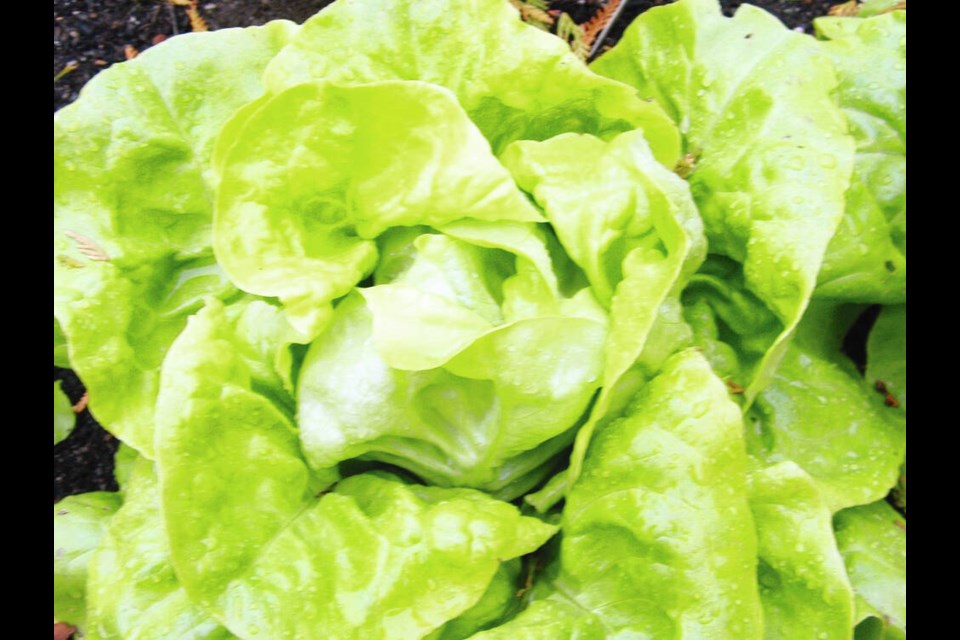Dear Helen: We are a large family of salad lovers. Butterheads are our favourite lettuces. To satisfy this preference and to produce as much of the our best-liked kind of lettuce as possible, I am looking for butterhead varieties that produce large, high quality heads. Do any from your lettuce growing experiences come to mind?
L.F.
The butterhead lettuce variety that springs immediately to mind is Hilde, a large butterhead that Dutch friends who raised six children recommended to me. Salt Spring Seeds lists it. The online catalogue describes Hilde as a large, vigorous, rapid-growing green butterhead that is “one of the most commonly grown lettuce varieties.”
William Dam Seeds lists Hilde II Improved: “Original Dutch butterhead lettuce. Giant white type. Time-proven butterhead produces large, light green heads with creamy green insides. Soft buttery texture.”
Hilde is a cool season lettuce best grown for spring and autumn harvesting, which means early sowing for spring harvesting and a midsummer to late summer sowing for fall and early winter harvesting. Hilde is hardy enough to be grown as a winter lettuce, along with other cold-tolerant types like Winter Density, Rouge d’hiver and Cimmaron — all romaine lettuces.
Lettuces classed as “hardy” still need covering in cold weather, and they are unlikely, even under tunneling and extra covers, to survive temperatures below -5 C.
Dear Helen: I try to protect my strawberries from rodent predation by growing the plants in boxes with wood sides and plastic mesh covers. This potential means of exclusion has not worked. I suspect the animals are digging under the enclosure sides to access the berries. You mentioned in a recent column that you use cotton balls soaked in peppermint oil to repel mice and rats. Do you mean the peppermint extract used in baking?
S.R.
I started using the peppermint extract from among the baking supplies in a kitchen cupboard, but found that to be unacceptably expensive. Still looking for a strong peppermint-scented rodent deterrent, I stumbled upon a mint mouthwash that I found too strong to use for its intended purpose. Instead, in the summer I diluted it with water and sprayed it around the base of the inside walls of the garden shed, where rodents sometimes shelter.
As the enclosed strawberry plants bloom and begin forming berries, it would be worthwhile soaking cotton balls in the undiluted liquid of a strongly mint-flavoured mouth wash and placing them around the perimeter of the boxes. Meanwhile, the mesh covering will continue to prevent birds from accessing the berries.
Dear Helen: Some of the hanging basket begonias I grew in the summer produced flowers quite unlike the blooms pictured on the packages. I have saved and stored all the tubers, the expected lovelies along with the disappointments, and wonder whether to plant them all in the spring.
B.D.
I have had this experience and have viewed it as just one more of many reminders that we live in an imperfect world.
When I have found a few unexpected and slightly disappointing colours on the begonia plants in hanging baskets, I have re-labelled them by colour, with a word or two of comment on how pleasing I find them. When I store the tubers in the fall, I insert the new labels into the storage medium alongside the appropriate tubers.
In the spring, once the tubers have been started into growth, I keep their labels in place as I move them into small pots for growing into transplant size,
As the weather begins warming in the spring and it’s time to move the plants outdoors into hanging baskets, I separate out the plants labelled as having produced the beautiful, expected flower colours and plant them in baskets that hang from the roof overhang across the front of the house.
The “semi-rejects” still put on a pleasant display of flowers in baskets hung from a structure beside a path leading into the back garden. Extras are planted in pots and placed on the spiralled platforms of an old wrought iron display stand — a discard from a friend’s house. Positioned at an edge of the back lawn, it has proven useful for potted “extras” among the spring’s flower transplants.



